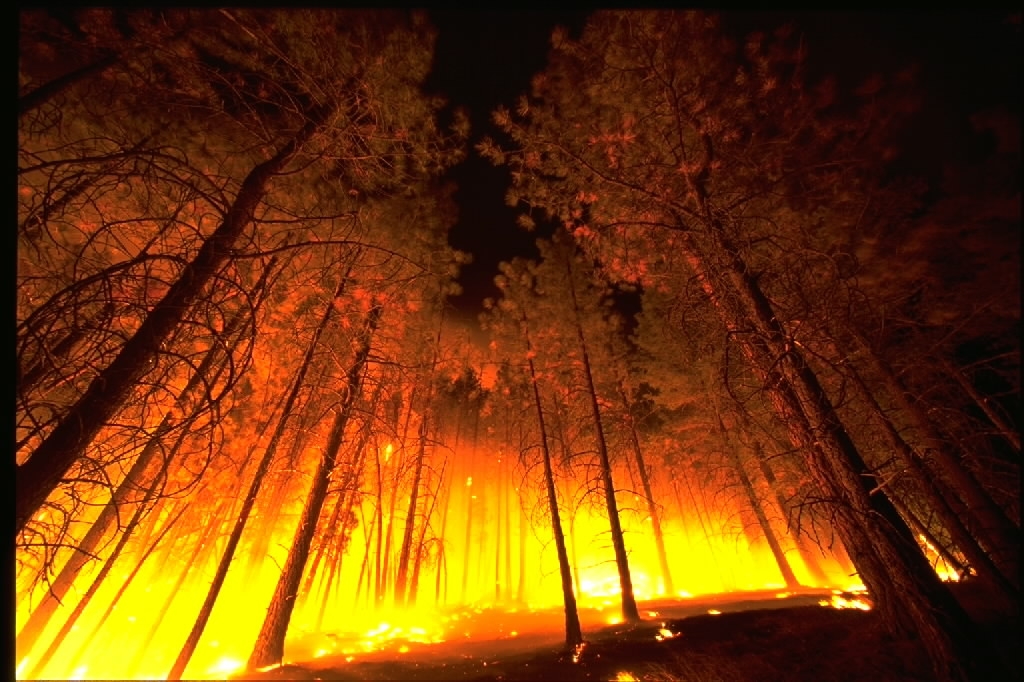Bushfires and Wine-making
Interview with
Chris - We're back to wine now and something else is a big problem, bushfires. But not for the reason you might think. And thankfully, Kerry Wilkinson might have a solution.
 Kerry - When a bushfire occurs or prescribed burning occurs in close proximity to wine regions, there's the risk that that smoke might linger around and in some cases, can be taken up by grape vines where smoke exposure occurs for an extended period of time. And what we see is that that smoke translates to a taint that can be detected in the wine in some cases.
Kerry - When a bushfire occurs or prescribed burning occurs in close proximity to wine regions, there's the risk that that smoke might linger around and in some cases, can be taken up by grape vines where smoke exposure occurs for an extended period of time. And what we see is that that smoke translates to a taint that can be detected in the wine in some cases.
Chris - Well, so what - there are chemicals, some kind of volatile agents in the smoke presumably that then adds or impregnates the surface of the grapes and this then gets carried over into the press?
Kerry - Some of these processes are still under investigation. We don't yet have all the answers, but it certainly seems to be that some of the components of smoke are being absorbed by grapevines and by fruit, and that these, they're carrying over into the wine and can influence the aroma and sensory properties of the finished product.
Chris - Is the effect always negative? Is it always bad news for the wine if that happens?
Kerry - We don't see an apparent taint in all wines where vineyard smoke exposure has occurred, but where it's prolonged, there is a risk that we some smoky burnt-meat type characters in a wine. And in some wines, particularly a delicate Riesling for example, this can be detrimental to the quality.
Chris - How much smoke do you actually need? So a bonfire in the vineyard is probably trivial but a big bushfire is likely to be more dramatic.
Kerry - That's true. The research is ongoing. So we haven't yet been able to say this is the minimum duration of exposure that's required to translate into a tainted wine. Where we have seen significant issues with smoke taint, it's generally a case of a large fire that's ongoing for a number of days or even weeks, and where that smoke hangs around for a considerable length of time.
Chris - And are all grape varieties equivalently susceptible to this or are some going to see their flavours impacted more than others?
Kerry - That's actually the focus of a current research project. We're actually looking at conducting a varietal of trial to see if there are any physiological characteristics of certain varieties that make them more or less susceptible. So the idea is that some of the characteristics of certain grapevines, for example their leaf area or their bunch size might influence the levels of smoke that are being absorbed in the field. And so hopefully, what we can do is identify varieties that are less susceptible to the uptake that might be more appropriate for growing in regions where, you know, they're prone to smoke.
Chris - Is there anything you can do about it once it's actually happened because in Victoria, I think last year where there were some fires, they had to throw away huge amount of wine?
Kerry - Yeah, the Australian wine industry, particularly in Victoria which has had a few incidences in recent years, they're really concerned with their brand. And so, in many cases, wineries aren't prepared to risk their reputation by putting out a product that they don't believe is up to their standards of quality. We've been conducting some research, looking at a technique that involves reverseosmosis and solid-phase absorption which might have the capacity. It certainly looks promising to try to overcome the issues of smoke taint and remove that taint.
Chris - So would you then take the product and try to extract just the molecules that are making that smoky taste or do you go to the grapes and do something to them?
Kerry - At this stage the amelioration techniques are being applied to wine and that's because some research has recently identified that some of these smoke compounds are being conjugated by the grapevines so they're present in more complicated forms than what we're able to detect. And what we've shown is that during wine making, these more complicated molecules are being broken down to release the compounds contributing smoke, smoky-type aromas. So, it's better for us to be treating the wine as a finished product to try to remove the offensive compounds rather than treating the grapes where, all the grape juice, where we're actually not able to target those molecules more specifically.
Chris - There must be hundreds, if not, thousands of different flavourants in an individual wine. So how do you know what's smoke and how do you know what's actually good, honest grape flavour?
Kerry - That's true. And even some of the compounds that are present in smoke are natural components of grapes as well. So that's part of the complication of determining a method that we can use for trying to remove smoke taint is coming up with techniques that, I guess, act more specifically on the offensive molecules and try not to have so much of an impact on the desirable compounds.
Chris - So how do you actually do that? Are you growing grapes and then wafting smoke over them so you can then see how much they take up or something?
Kerry - We actually are. We're conducting a number of fume trials where we build purpose-built smoke tents around our grape vines and we then generate smoke and put smoke inside these tents for a specified period of time, and we come back and collect grapes at different times afterwards or harvest the grapes, once they're mature to make wine out of them to conduct a number of chemical and sensory analyses at a later date.
Chris - And have you got some candidate compounds that you know translate into these nasty aromas that you think you can now remove?
Kerry - There are two marker compounds that are currently being used, guaiacol and 4-methylguaiacol. And these are reasonably liable indicators when their levels are higher in smoke-affected grapes and smoke-affected wines it tends to correlate with higher levels of perceived smoky characters. The complication is that these compounds are also derived from barrel maturations. So when a wine is matured in a barrel, you'll see these compounds as well. So we know that they're not solely responsible. And an ongoing research is trying to identify some of the other compounds that are responsible.
Chris - And the removal process, how effective actually is that and does it leave the wine fairly otherwise untainted then?
Kerry - The project that we ran last year, we took a smoke tainted pinot and it had quite an apparent smoky character and we we're able to reduce the levels guaiacol from 12 micrograms/ litre, down to 5 micrograms/litre. And perhaps, most importantly, was the sensory results we got from this. And our panel could readily distinguish between the wine before and after treatment, but not only that, there was an improved acceptability of the wine after treatment. So it had less intense smoky-type characters and more intense fruit characters. There is the potential that we're also removing desirable flavour compounds. You know, we don't deny that. But it does seem to be a process that at least gives wine makers some hope where they, you know, don't have too many options available to them.










Comments
Add a comment